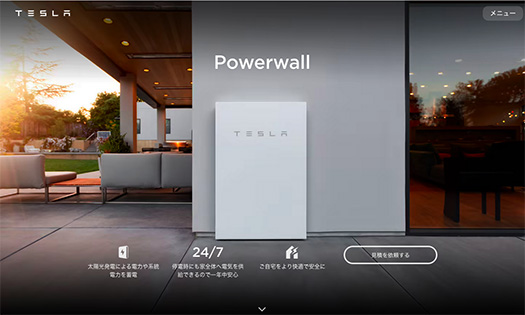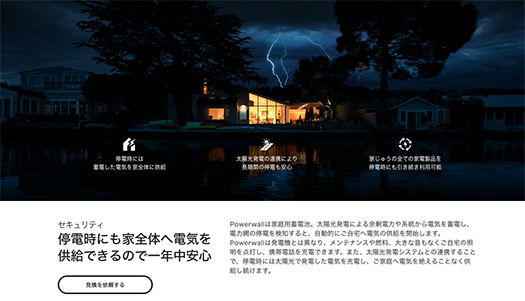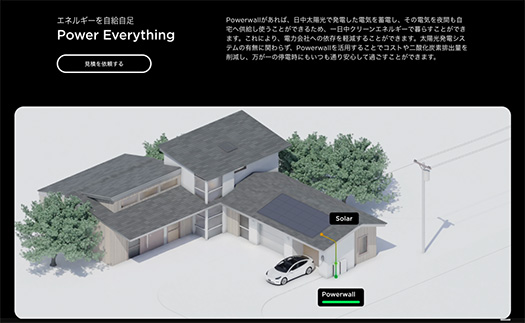


さてきのう「積雪寒冷地・クルマの未来はどうなる?」と記事を書いたら
いろいろな反響ご意見を戴きました。
たまたま愛車がトラブったのでその経緯に沿って考えて見た次第。
で、本日はその続篇で北国積雪寒冷地での住宅エネルギーの問題です。
写真はきのうやや批判的に触れたTESLA社のホームページから。
太陽光発電と蓄電池というわかりやすい住宅エネルギー提案であります。
とくに蓄電池技術についてEV開発との連携で最重要テックなので、
当然のように住宅エネルギーとの連携が謳われているワケです。
クルマの大変化は必然的に住宅をも大変化させることがあきらかですね。
いま、各電力会社ではこのTESLAの提案と同様の太陽光発電+蓄電池という
セットを提供しメンテナンスも引き受け、でもトータルの電力料金は
これまでと比べてほぼ同等というサービスを提供し始めている。
日本では住宅の高断熱高気密化は寒冷地から温暖地域に広がった。
しかしEVという与条件では温暖地主導型のエネルギー源選択になる。
住宅エネルギーとは照明、暖房、調理・給湯の用途。
そこにガソリン車が生活移動装置としてこれまでカーポートなどに置かれた。
北海道のような生活面積の広い地域、あるいは全国の地方では
公共交通手段とのアクセスが難しいことからクルマ依存が進んでいる。
クルマはドラえもんの「どこでもドア」として機能し、
温暖地の大都市圏のような公共交通に依存できない地域ではまさにインフラ。
そういう実態を反映して街自体もAEONのような広大な駐車スペース空間で
買い物からレジャーの現代利便性機能を果たしてきた。
クルマは住宅と都市計画レベルでいわば前提条件を構成している。
積雪寒冷地でこのクルマがEVに移行するとなると、
冬場には太陽光発電効率が極端に低下する。屋根設置では効率低下は
避けられないので、壁付けもあり得るかも知れないが、
まぶしさなど、近隣配慮の問題が発生するだろう。必然的に、
系統電源から必需エネルギー供給を受けることになる。集中的需要の発生。
冬場、大雪が続くときなど系統電力にかかる負荷は相当レベル。
この発電容量は大丈夫かという社会全体の問題も大きい。
温暖地域であれば考慮しなくてもいいような事象について
住宅建築の側では相当に「配慮」して行く必要があるし、
当面は試行錯誤、苦情の発生が避けられない可能性がある。
家庭でのクルマへの充電は太陽光発電由来の電力を
「充電スタンド」から充電することになるけれど、ここでも
「寒冷地ではできればカーポート」内での設備が安全側となるだろう。
温暖地であれば玄関ポーチ型が主流になるものが、よりコスト負荷が大きくなる。
総じて温暖地とはまったく違った社会コストを覚悟する必要がある。
TESLAホームページではすぐに「見積もり」というリンクがあるけれど
ユーザー側からすると、コスト不安は避けられないだろうと思う。
CEOのマスク氏は「日本は衰退滅亡する」と発言したそうだが、ひょっとして
こういうコスト負担に日本の積雪寒冷地は耐えられないと見越しているのだろうか?
English version⬇
What is the future of snowy, cold weather and residential energy?
Cars are essential infrastructure in a wide living area. What will happen to our lives in the winter when PV power generation is difficult? ・・・・・・・.
Yesterday, I wrote an article titled “What is the Future of Cars in Snowy and Cold Regions?” I wrote an article titled “What is the Future of Cars in Snowy and Cold Regions?
I received a lot of feedback and opinions.
My car happened to be in trouble, so I thought I’d share my thoughts along the way.
Today, I would like to continue the discussion on the issue of residential energy in the snowy and cold regions of northern Japan.
The photo is from TESLA’s website, which I mentioned somewhat critically yesterday.
It is an easy-to-understand proposal for residential energy, consisting of photovoltaic power generation and storage batteries.
The storage battery technology, in particular, is the most important technology for the development of EVs.
This is why the linkage to residential energy is mentioned as a matter of course.
It is clear that the major changes in the car industry will inevitably lead to a major change in the residential sector as well.
Power companies are now offering a solar power generation + storage battery system similar to the TESLA proposal.
and maintenance, but the total cost of electricity is about the same as before.
However, the total cost of electricity is almost the same as before.
In Japan, the trend toward highly insulated and airtight homes has spread from cold regions to warmer regions.
However, the choice of energy source for EVs is driven by the warmer climate.
Residential energy is used for lighting, heating, cooking, and hot water.
Gasoline-powered vehicles have been placed in carports and other locations as a means of transportation for daily life.
In regions with a large living area like Hokkaido, or in rural areas of the country.
The car is becoming increasingly dependent on the car due to the difficulty of accessing public transportation.
Cars function as Doraemon’s “door to anywhere” and
In areas that cannot rely on public transportation, such as metropolitan areas in warmer regions, they are the very infrastructure.
Reflecting this reality, the city itself is also developing a vast parking space like AEON.
AEON-like vast parking spaces have fulfilled the function of modern convenience for everything from shopping to leisure activities.
The car constitutes a prerequisite, so to speak, at the level of housing and urban planning.
If these cars were to be converted to EVs in snowy and cold regions
In winter, the efficiency of photovoltaic power generation will drop drastically. Roof-mounted solar power generation systems will inevitably have lower efficiency.
However, wall-mounted solar power generation may be a possibility.
glare and other neighborhood concerns. Inevitably, the
grid power supply to supply the necessary energy. Concentrated demand.
In winter, when heavy snowfalls continue, the load on the grid power is considerable.
The question of whether society as a whole will be able to handle this generation capacity is also a major issue.
In a temperate region, there is no need to take into account
In the case of residential construction, it is necessary to give considerable “consideration” to such events, and
For the time being, trial and error and complaints may be inevitable.
Charging the car at home will be done by using electricity derived from photovoltaic power generation.
However, even here, it is difficult to charge the car from a charging station.
In cold climates, it would be safer to install the charging station in a carport if possible.
In warmer climates, the cost burden will be greater for the more common front porch type.
In general, we need to be prepared for social costs that are completely different from those in warmer climates.
Although the TESLA website has a link to “estimate” right on the homepage
I think cost concerns are inevitable from the user’s side.
Mr. Mask, the CEO of TESLA, is said to have said that “Japan will decline and perish.
Is he anticipating that Japan’s snowy and cold regions will not be able to bear this kind of cost burden?
Posted on 5月 10th, 2022 by 三木 奎吾
Filed under: 住宅マーケティング, 日本社会・文化研究







コメントを投稿
「※誹謗中傷や、悪意のある書き込み、営利目的などのコメントを防ぐために、投稿された全てのコメントは一時的に保留されますのでご了承ください。」
You must be logged in to post a comment.